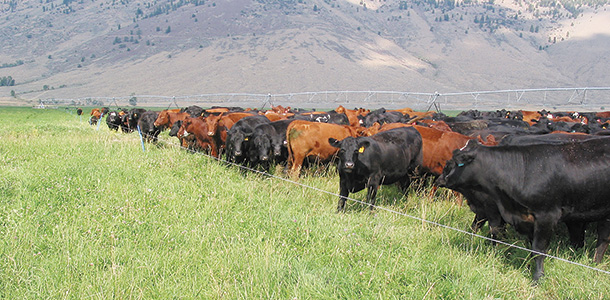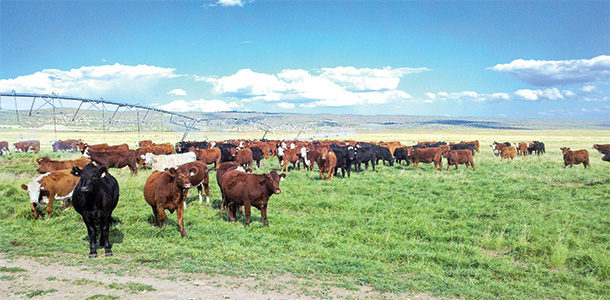Irrigated pasture can be more productive than the same ground used for haying, according to Jim Gerrish of American Grazinglands Services in May, Idaho. He was involved with innovative grazing systems (Forage Systems Research Center) at the University of Missouri and is now a stockman and consultant in central Idaho, practicing these principles on the Circle Pi Ranch.
“Here we do daily pasture rotation with cattle on center pivots. Irrigated pasture has high production potential and ability to regrow rapidly.
We do a fast rotation, putting water back onto a strip the day or two after it’s grazed. This accelerates regrowth and creates opportunity for growing another crop,” he says.
“Most of our pastures are grazed four times in a season. Compared to good hay production in our valley (which has a short growing season), on average we get 40 to 50 percent higher dry matter production harvesting with livestock than what we’d get if it were all being taken as hay,” he says.
Pastures are strip grazed under pivots, using the inner circle design. “We have stock water spaced out along the inner circle, which makes movement of temporary fences very efficient.
It shortens the distance you have to go, and short travel distance to water for the cattle,” he explains.
“This year we started monitoring output from the pivot. A brand-new pivot is very uniform in water distribution, but water in our creek from snow melt on the mountain is gritty and scours the nozzles,” says Gerrish.
“We had our pivots re-nozzled four years ago. When we checked their output recently, I was shocked at the variation across the pivot (20 percent variability).
If the pivot was set to put on an inch of water every three days, we were actually getting somewhere between 0.8 and 1.2 on most nozzles.
The 10 percent that didn’t fall into that standard deviation varied from as little as 0.5 inches to over 1.5 inches. Don’t rely on what the panel says you are putting out,” he says.
He uses multiple rain gauges that he moves as the pivots move, and checks them. This gives an idea of how much water is actually put out.
For people with limited water, keeping nozzles in shape helps get more out of every inch of water available.
Eagle Valley Ranch near Salmon, Idaho, began using management-intensive grazing several years ago, grazing cattle on irrigated forage they originally harvested for hay.
Mike Kossler, ranch manager, says they move cattle frequently and try to leave residual forage. “The amount we leave depends on the leaf base. If you leave enough, it comes back a lot quicker,” he says.
Grass grows faster in spring and early summer than in July and August when it’s hot. Irrigation helps keep it growing better.
“Pivot irrigation is an easier way to keep things wet when it’s hot versus flood irrigation. You can water some pastures more effectively, putting a certain amount of water, whereas it’s hard to get across them with flood irrigation when water won’t go as far.
With a pivot, you can manage on a really hot day to actually deliver the needed water and keep it wet,” Kossler says.
“We have some ground we can’t hay, and that’s where we concentrate the cows to keep it eaten off because we can’t cut it.
We also have a 180-acre pivot we put into a clover/grass mix, and we hay it once – and get 2.5 to 3 tons to the acre.
Then we let it grow back about 8 to 10 inches tall and put calves on it after they are weaned, and they gain 2.5 pounds per day. That gives us two good crops off that piece,” he explains.
“We get more production doing intensive grazing. Many ranchers could run more cows by managing pastures this way – and that’s a big deal with the price of cattle today.
There’s some labor because we move a wire every day, but we’re set up with some infrastructure and it only takes 30 to 40 minutes,” says Kossler.
Charles Redd of La Sal, Utah (30 miles southeast of Moab) feels one of the great things is improvement in quality of life that comes with switching from hay to grazing.
“For 30 years, we raised hay and fed it to our own cows or shipped to dairies in the Southwest or horse markets in the East. In 2009, we decided we wanted something different.
When you raise hay all summer, you have to be there all winter to feed it or sell it,” he says. It requires expensive inputs in machinery, fuel, repairs and labor.
“It’s been stress-reducing for us to switch from harvesting forage mechanically to harvesting with animals.
We’ve been in a drought, and it’s easier and less costly to manage livestock numbers than managing equipment that sits parked under the shed with payments that continue, with nothing to put through the equipment,” says Redd.
“We have center pivots, side rolls and flood irrigation, with 80 percent of our acreage under pivots. Water for pivots is piped from a creek.
Our pasture is on a slope, so pressurization of sprinkler systems is by gravity; we don’t have pumping costs,” he says.
“We depend entirely on rainfall and snowpack for irrigation; we don’t have any storage. Traditionally, we have water until about July 1, and then it tapers off.
But this works well with grazing livestock because we can manage livestock numbers to be more in line with forage production.
Haying equipment sat idle in late summer, some years,” he says. He sold his expensive haying and tillage equipment except for an old round baler and small square baler to harvest forage that gets ahead of the cattle.
His ranch is at 7,000 feet elevation with limited water (12 inches annual precipitation at the ranch). This influences forages that grow best in that environment.
People should plant forages that do well and not necessarily what they want or what someone else is using in a different environment.
He has about 900 acres under sprinkler, 300 acres of flood-irrigated pastures and 2,000 acres of improved dryland pasture. “In an average growing season, we can run about 1,800 heifers. Our water situation dictates how many and for how long,” he says.
Some dairies are using irrigated pasture for cows as well as young stock. Sean Mallet’s organic dairy near Twin Falls, Idaho, pastures 2,500 animals.
“This includes 1,200 milking cows, the dry cows, youngstock and replacements,” he says.
“Being an organic operation, we are required to graze at least four months each year. All animals older than 6 months are required to get at least 30 percent of their dry matter intake from pasture, and that must be documented,” he says.
The farm has 650 acres of pasture, mostly under pivot, along with wheel lines and hand lines. “We run the heifers 6 to 12 months old together.
We also have a breeding group and run the 15-month to 24-month heifers together and dry cows as a separate group. We have five different groups of milking cows that we intensively graze.
The milking cows are turned out to a fresh pasture after morning milking and go to that same paddock after the evening milking,” he says.
“Good pasture takes 36 to 40 inches of water per acre each year. We try to accomplish that but generally end up around 30 to 35 inches.
We try to keep irrigation on the pasture as much as possible, so if we are grazing half the pivot, we’re running water on the other half,” he says.
“One thing that helped this year was technology we installed that enables us to monitor pivots from a computer or smartphone.
We can vary the rate and know how much water we’re putting on. If we have to reverse a pivot so it won’t run over the fences, we can set that up on the computer.
At a certain position, it will automatically reverse so we don’t have to go out and do it at 10 o’clock at night,” says Mallet.
The farm is about 4,500 feet elevation, on the high desert. Sprinkler irrigation keeps pastures growing fairly well even during the heat of summer.
“This past summer took its toll, however. No matter what we did, it was difficult to keep enough water on the pastures. We had three months of record heat and one month of 10 degrees over average. This takes a lot of water,” says Mallet.
“We keep our sprinkler packages working up to par. We installed the technology on three pivots this year. If the pivot gets stuck, it sends you a text and you can do something right there rather than going out to do it,” he says. FG
Heather Smith Thomas is a freelance writer based in Idaho.
PHOTOS
Hay is harvested with cattle rather than machinery under pivots on Charles Redd’s Utah farm. Photo courtesy of Charles Redd.












